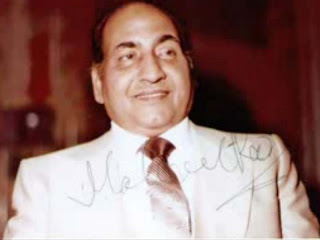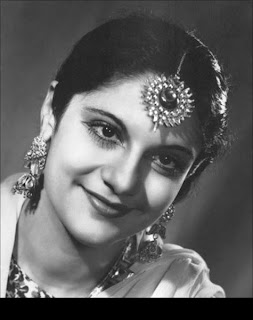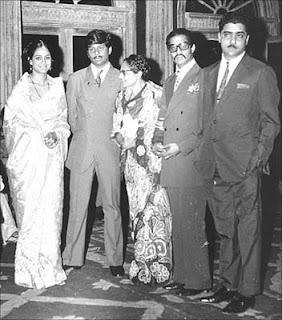
A Humble Tribute to the Greatest Playback Singer of all times – by Nasir.
Having discussed about Suraiya in the last article, I still find myself in a swoon at the mention of her name. However, sometimes I wonder how could Rafi Sahaab have escaped the charms of Suraiya while singing such romantic songs with her. As we have observed in the last article, that was the time when her presence used to cause traffic jams, people used to stalk her, rob her records to hear her voice in solitude, and even Dev Anand the lady killer wanted to marry her. Not to mention the mischievous shooting retakes of Dilip Kumar with her in K.Asif’s Janwar - when she finally withdrew herself out of suspicion after returning the signing amount, never to act opposite Dilip Kumar.
It's time for some musings now: Though the songs of Fifties are out of the scope of this article, I cannot help but mention DIL KO HAAY DIL KO, DIL KO TEREE TASVEER SE, BEHLAAYE HUWE.N HAI....(Dastaan 1950) Just listening to this song races my blood, makes my heart beat faster, while the body shakes to the rhythm of the song. Just mere thoughts whip up the hidden desires to be with the “Chocolate Charmer” in the sylvan setting of the Omar Khayyam Rubaiyat:
A Book of Verses underneath the Bough,
A Jug of Wine, a Loaf of Bread—and Thou
Beside me singing in the Wilderness—
Oh, Wilderness were Paradise enow!
I wonder how the young pair of Rafi and Suraiya must have recorded that song. Ordinarily, sparks should have flown.
Now this is no speculation: Noor Jahan or Suraiya; or Saira Banu or Sharmila Tagore (in 1963 and 1967) or even Tina Munim (in 1980) Rafi Sahaab always concentrated on the songs and not the female singer’s beauty and bearings. It was only through his singing voice that he conveyed the inner emotions of love and romance. He was never involved in any filmy romance or scandal at all throughout his life. Neither did he need a "Jug of Wine". He could easily bring himself to sing like an incorrigible boozard or like an occasional drinker drowning his sorrows in the goblet or trying to enlist the virtues of wine, or discoursing on the philosophy of life. But all of those songs pertain to the Fifties, the Sixties, and the Seventies. If he needed any jug, it was of rich tea laced with almonds and pistachios which he shared with others during the recordings. At times he even went to drink Lassi with a musician. The “Book of Verses” pertain to the lyrics that he sang and recorded. While the “Loaf of Bread” that he earned he divided it between his family on the one hand, and the poor and the needy on the other. As for the “Wilderness,” he lived in the tinsel town as if it were a wilderness - in a true Sufi spirit – i.e. he lived in the world but was not swayed by the world and its temptations and sins, or glamour and greed, or rivalry and cunning. Man, that’s not easy. Just try living like that! So much for the Rubaiyat of Omar Khayam!
Lata Mangeshkar was slated to become a much sought-after female playback singer chiefly owing to the encouragement of Ghulam Haider who stood by her when others had rejected her as we noted before. Naushad too wanted to have a share in this “discovery”. Much to the surprise of the reigning Shamshad Begum, Andaz had all her songs for the heroine Nargis. Shamshad Begum had just one song (filmed on Cuckoo), and that was the duet with Lata Mangeshkar: DAR NAA MOHABBAT KAR LE. But it seems that he had sought the permission of Mehboob Khan for using Lata Mangeshkar. Also, he would make her do the rehearsing for days on end before the final take would be recorded in the presence of Mehboob Khan. It thus appears that Mehboob Khan would interfere in Naushad’s work. One day, the witty Naushad would make him eat a humble pie by giving him a tit for tat. Once during a shooting of some movie (I don’t remember at this moment which one was that - probably it was Andaz) Naushad went right up to the camera, brushed Mehboob Khan aside, peeped into the camera lens and said that the camera- angle was not proper. Bemused with this remark of Naushad, Mehboob Khan asked him what he knew about the cameras and their angles and shots. “Nothing,” said Naushad. In the next breath he put the counter-question to Mehboob: “What do you know about music, Ragas, the Raginis?” Mehboob Khan got the hint. It is said that from that onwards he never interfered with Naushad’s system of work. Speaking of Andaz, it was released at the new Liberty Cinema which opened in March 1949 with a capacity for 1200 seats to generate Rupees Forty Thousand per week with the price of tickets ranging from ten and a half-anna to Rupees Three and half. Indeed, Mehboob Khan's Andaz received a tremendous ovation! Rafi Sahaab had a duet song with Lata Mangeshkar, picturized on Raj Kapoor and Nargis: Yoo.n toh Aapas biga.Dte hai.n Khafaa hote hai.n. Here, it was Mukesh who had the choicest of songs filmed on Dilip Kumar, with one song KYOO.N PHERI NAZAR being scrapped from the movie! There was another song that was not released. This was Rafi-Lata duet: SUNLO DIL KA AFSAANA HO... Maybe this was meant for Raj Kapoor and Nargis.
As for Naushad, he had grown big since his Prem Nagar (1940) days. In late ‘Forties, he began to have a large orchestra. His Indian classical music had a western arrangement. However, his greatest musical wonders were reserved for Nineteen Fifties when he would provide music for Babul, Dastaan, Jadu, Deedar, Aan, Deewana, Baiju Bawra, Amar, Shabab, Uran Khatola, Mother India, Sohni and Mahiwal. And for his movies of the ‘Sixties such as Kohinoor, Mughal-e-Azam, Ganga Jamuna, Mere Mehboob, Leader and Dil Diya Dard Liya, Ram Aur Shyam, Aadmi, to name a few only.
Playback singers Mohammed Rafi and Lata Mangeshkar had already become household names. Even as late as 1949, Lata Mangeshkar would still be singing in the style of Noor Jahan as her songs from Mahal, Andaz, Padmini, and even in Barsaat, would suggest.
The Mahal song AAYEGA AAYEGAA AAYEGAA AANEWAALA AAYEGAA AAYEGAA composed by Khemchand Prakash, was a super-hit and it zoomed her career. This song used to be played on loudspeakers time and again at most of the nooks and corners of towns and cities, and I myself remember hearing this song as a three-year kid whenever I went out to buy myself some ‘Gulgule’. Mahal was a huge success for Kamal Amrohi - though I am told it was released and soon removed from the theatres. It was only after the re-run soon thereafter that it caught on. I remember that initially Madhumati (1958) was criticized by drawing comparison with Mahal. In my personal opinion, Mahal has heavy overtones of mystery, while Madhumati is a superb entertainer in all respects. The fact remains that Mahal zoomed the playback singing career of Lata Mangeshkar. Importantly, Madhubala who had started acting since the age of 11 and then gone to become a heroine in Neel Kamal (1947) opposite Raj Kapoor at the age of 14, tasted tremendous success in Mahal opposite Ashok Kumar as a result of her mystical performance, so that the filmy world now lay at her feet. Within the next four years, she was to star in some 24 movies, with her fame reaching even Hollywood where the magazines portrayed her as a mysterious and delicate woman of mythical beauty whose fans were a legion.
The year 1949 saw the Government of India raising the entertainment to a ridiculous extent (50% of the rate of admission in more than one Province), thus leading to protest and closure of cinemas all over India. New censorship classification code came into existence, and censorship was made a Central Subject according to the recommendations of the new Film Enquiry Committee that was chaired by S.K. Patil. There were now "A" and "U" censor certificates for Adults and Universal exhibitions respectively. The Film Division was launched. Exhibition of approved documentaries before screening of the movie was made compulsory. Funeral procession of Sarojini Naidu was filmed at about this time for the Indian News Review. Now I understand why as a kid I had to wait for at least half an hour or so watching the news that I then found torturous. To make matters worse, sometimes in their zeal, they would come out with a second documentary too. This was also the time when Finance Ministry booked the tax evaders and some producer-director-exhibitors and or financers were asked to pay various sums of Rs. 36 laksh, 22 lakhs, 15 laksh, 13 lakhs and so on. Please remember that these were a very astronomical sums of money during those days. By this time, a new colour process known as Geva Colour was perfected in the country.

Out of nostalgia for my childhood friends, Hyder Ali and Asghar Ali, now I would like to make a mention of their mother, actress Pramila (Esther Victoria Abraham) who, in 1949, was crowned the First Miss India 1947. She joined the theatre company and later went on to become the vamp and a fearless stunt star in many movies that included Ulti Ganga,Bijli,Jungle King and Basant. In Basant (1942) the Amirbai Karnataki’s song, HUWA KYAA QASOOR was picturised on her. She was also a major film producer in her hey days. Her last film was at the age of 92, entitled Thaang. It is a Marathi film which is directed by Amol Palekar. She was once wrongly arrested at the instance of Morarji Desai, on charges of being a spy simply because she used to visit Pakistan to see her father and also for the business of film distribution. She was the fighter all her life and never gave up under any circumstance. I had the opportunity to see her and her husband Kumar sometimes in the mid-Fifties when I visited her home near the Paradise Cinema at Mahim, Mumbai, along with her son Hyder Ali who was my classmate in the Belvedere Convent which used to be located by the side of the Scottish Orphanage at Cadell Road. Asghar Ali was one year senior. Later Hyder Ali joined the St. Michael High School. I still remember a skit presented in the school by Asghar Ali. It was, what used to be called “record dance.” He and a girl gave a brilliant dance performance while the Kishore Kumar-Lata Mangeshkar record, MERA NAAM ABDUL REHMAN was played in the background. I know that Hyder Ali also performed in the TV shows of Nukkad in the Eighties, though I never had a chance of meeting him after the school days.
To continue....

Hyder Ali and Asghar Ali with their mother Pramila and family.
Dear Mr. Nasir,
ReplyDeleteI am also an ex student of Belvedere School, Mahim. I read about your blog in the hamara forum. I am anxious to interact with you, in case you are interested. My contact number is 9892796365
Thanks
Sunil Varma
ReplyDeleteThank you for such a well written article. It’s full of insightful information and entertaining descriptions. Baby Chocolate | Chocolate Gifts | Luxury Chocolate | Luxury Chocolate